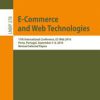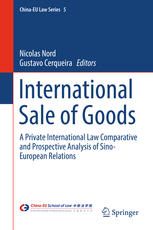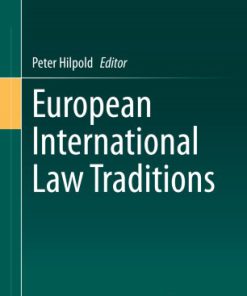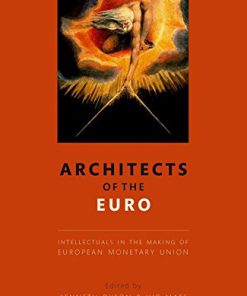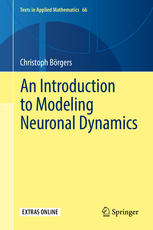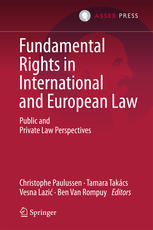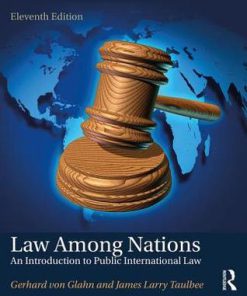International and European Monetary Law An Introduction 1st Edition by Christoph Herrmann, Corinna Dornacher 3319576428 9783319576428
$50.00 Original price was: $50.00.$25.00Current price is: $25.00.
International and European Monetary Law An Introduction 1st Edition by Christoph Herrmann, Corinna Dornacher – Ebook PDF Instant Download/DeliveryISBN: 3319576428, 9783319576428
Full download International and European Monetary Law An Introduction 1st Edition after payment.

Product details:
ISBN-10 : 3319576428
ISBN-13 : 9783319576428
Author: Christoph Herrmann, Corinna Dornacher
This book introduces the fundamental monetary law problems of cross-border economic activity and the solutions thereto in international monetary law, and in EU law. After decades of having been neglected by legal scholars, international and European monetary law has attracted increasing attention in recent years. With the European Economic and Monetary Union (EMU), a full-fledged monetary union between sovereign States has been established for the first time in history. Its construction is primarily a work of law, with the Treaties on European Union (TEU) and on the Functioning of the European Union (TFEU) together with a number of protocols forming the constitutional basis. Yet, European monetary Integration has never taken place in isolation from international developments. Moreover, international monetary law, namely the Articles of Agreement of the International Monetary Fund (IMF) has always played a role – initially as the external monetary addition to the internal market project, after the breakdown of the Bretton Woods System in the 1970s as one of the major driving forces for monetary Integration within the EU. On a fundamental basis, international and European monetary law address the same principled problems of monetary cooperation: how to proceed with financial transactions cross-border where no global currency exists. The present work describes the different approaches and relations and interplay between the two legal regimes.
International and European Monetary Law An Introduction 1st Table of contents:
1 Interdisciplinary Introduction to Money and Currencies
1.1 History of Money
1.1.1 What Is Money?
1.1.2 Historical Development of Money
1.2 Monetary Policy Basics
1.2.1 Two-Tier Mixed Monetary System
1.2.2 Monetary Aggregates
1.2.3 Monetary Policy and Policy Instruments
1.2.4 Currencies
1.2.5 Monetary Policy and Fiscal Policy
1.3 Money and the Law
References
2 Monetary Sovereignty and History of International Monetary Law
2.1 Monetary Sovereignty under Public International Law
2.1.1 The General Principle of Sovereignty
2.1.1.1 Content of the Principle
2.1.1.2 Historical and Theoretical Development of the Principle
2.1.2 Monetary Sovereignty
2.1.2.1 Content
2.1.2.2 Erosion of the Principle
2.2 History of International Monetary Law
2.2.1 Gold Standard
2.2.2 The Creation of the Bank for International Settlements (BIS)
2.2.3 The Establishment of the IMF
2.2.4 The IMF’s Development
2.2.4.1 The Collapse of the Par Value System
2.2.4.2 Second Amendment to the IMF Articles of Agreement
2.2.4.3 Further Amendments
References
3 Fundamental Legal Problems of International Monetary Relations
3.1 Lack of a Universal Currency
3.2 Convertibility
3.3 Exchange-Rate Systems
3.4 Free Movement of Capital
3.5 International Liquidity
3.6 The Trilemma of Monetary Policy
References
4 The International Monetary Constitution: The IMF Articles of Agreement—Institutional Design and
4.1 Institutional Design
4.1.1 The IMF within the International Setting
4.1.2 The Legal Framework of the IMF
4.1.3 Institutional Design
4.2 Decision-Making Procedures/Processes
References
5 The International Monetary Constitution: The IMF Articles of Agreement—Substantive Legal Obligat
5.1 Convertibility
5.2 Exchange-Rate Regimes
5.3 IMF Surveillance
5.4 Technical Assistance
References
6 IMF Lending (Financial Assistance)
6.1 Financial Architecture and IMF Resources
6.1.1 Financial Architecture
6.1.2 Financial Resources
6.2 Types of IMF Facilities
6.2.1 Non-concessional Financing
6.2.2 Concessional Financing
6.3 Modalities of and Access to IMF Facilities
6.3.1 Access Limitations
6.3.2 Modalities of IMF Facilities
6.3.3 Conditionality
6.3.3.1 The Legal Base for Conditionality
6.3.3.2 The Rationale and Critique of Conditionality
6.3.3.3 Conditionality in Practice
6.4 Crisis Management
6.5 The IMF and Currency Unions
6.5.1 IMF Membership
6.5.2 The IMF and Currency Unions in Practice
References
7 History of European Monetary Law
7.1 The Historical Development of the European Monetary Constitution
7.1.1 First Initiatives of Multilateral Monetary Cooperation in Europe
7.1.1.1 The European Payments Union
7.1.1.2 The EEC Treaty
7.1.2 Monetary Implications of the European Integration Process
7.1.3 The Evolution of the European Economic and Monetary Union
7.1.3.1 The Werner Report
7.1.3.2 The ‘Snake in the Tunnel’
7.1.3.3 The European Monetary Cooperation Fund
7.1.3.4 The European Monetary System
7.1.3.5 The Delors Report
7.1.3.6 The Maastricht Treaty
References
8 The Legal Framework of EMU post Lisbon—Institutional Setup
8.1 ESCB and ECB
8.1.1 Institutional Design
8.1.2 Eurosystem Objectives and Tasks
8.1.3 ESCB Decision-Making
8.1.4 Central Bank Independence
8.2 ECOFIN Council and Eurogroup
8.3 Commission
8.4 Economic and Financial Committee
References
9 The Substantive Legal Foundations of EMU post Lisbon
9.1 Basic Features of EMU
9.2 Membership and Territorial Scope of the Euro Area: Ins and Outs
9.2.1 Convergence Criteria
9.2.2 Procedure
9.2.3 The Exception: “Outs”
9.2.4 Relationship Between Ins and Outs
9.2.5 Termination of Membership
9.3 The Euro as Legal Tender
9.3.1 Legal Tender Status and Issuance of Banknotes and Coins
9.3.2 Regulations Introducing the Euro
9.3.3 The Euro in Third Countries
9.4 Free Movement of Capital and Payments
9.4.1 Reasons for the Liberalization
9.4.2 Content and Scope of the Freedom
9.4.2.1 General Freedom
9.4.2.2 Exceptions
References
10 The Monetary Policy of EMU
10.1 Legal Foundations and Limits
10.1.1 What is Monetary Policy and How Does it Work?
10.1.2 The Eurosystem’s Monetary Policy Mandate
References
11 Economic Policy Coordination in EMU
11.1 The Case for Economic Policy Coordination in EMU
11.1.1 Primary Law Foundations of Economic Policy Coordination
11.1.1.1 Coordination (‘Positive Integration’)
11.1.1.2 Prohibitions (‘Negative Integration’)
11.1.1.3 Emergency Assistance and Liability Clause
11.1.2 Secondary Law
11.1.2.1 The Stability and Growth Pact (SGP)
11.1.2.2 Six-Pack and Two-Pack
11.1.3 Extra-Union Law Measures
11.1.3.1 TSCG
References
12 The External Relations of EMU
12.1 The Acting Institutions/Entities
12.1.1 The Division of Competence
12.1.2 The Doctrine of Parallelism
12.1.3 Judicial Review
12.2 Exchange-Rate Policy of EMU
12.2.1 Objective of Exchange-Rate Policy
12.2.2 Formal Exchange-Rate Arrangements (Art. 219 (1) TFEU)
12.2.3 Floating Exchange-Rates (Art. 219 (2) TFEU)
12.2.4 Agreements Concerning Monetary or Foreign Exchange Regime Matters (Art. 219 (3) TFEU)
12.2.5 Tasks of the ECB (Art. 127 (2) TFEU)
12.3 International Relations of EMU
References
13 EMU and the Sovereign Debt Crisis—Legal Aspects of Financial Assistance for Member States
13.1 Evolution of a Crisis
13.2 Measures of Member States
13.2.1 Measures Based on Extra-Union Law
13.2.1.1 Bilateral Loans
13.2.1.2 European Financial Stability Facility (EFSF)
13.2.1.3 European Stability Mechanism (ESM)
13.2.2 Measures Based on EU Law
13.2.2.1 European Financial Stabilization Mechanism (EFSM)
13.3 Legal Assessment
References
14 EMU and the Sovereign Debt Crisis—Legal Aspects of Monetary Policy Responses and the Banking Un
14.1 The Monetary Policy Reactions to the Crisis
14.2 Non-standard Monetary Policy Measures
14.2.1 Enhanced Credit Support
14.2.2 Qualitative Easing
14.2.3 Structural Open Market Operations
14.2.3.1 Asset Purchase Programmes
14.2.3.2 The Securities Market Programme
14.2.3.3 The Outright Monetary Transactions Programme
14.2.3.4 Quantitative Easing
14.3 Legal Assessment
14.4 Banking Union
People also search for International and European Monetary Law An Introduction 1st:
international monetary fund laws
international law money laundering
international monetary fund ap euro
international monetary law
international law europe
Tags: International, European Monetary, An Introduction, Christoph Herrmann, Corinna Dornacher
You may also like…
Jurisprudence & Law
Politics & Philosophy - Government & Politics
Medicine
Eye Movement Research An Introduction to its Scientific Foundations and Applications Christoph Klein
Jurisprudence & Law
Jurisprudence & Law - Foreign & International Law
Jurisprudence & Law
American law: an introduction Third Edition Lawrence Meir Friedman


